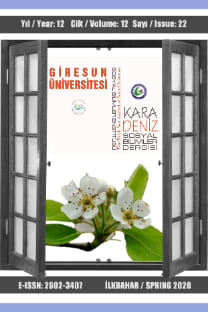2008 Küresel Krizi ve Değişen Para Politikaları: Dünyada ve Türkiye’de Faiz Koridoru Uygulaması
Faiz Koridoru, Küresel Ekonomik Kriz, Merkez Bankası, Para Politikası
2008 Global Crisis and Changing Monetary Policy: The Practise of Interest Rate Corridor in the World and Turkey
___
- Alper, K., Altunok, F. ve Çapacıoğlu, T. (2015). “ABD Merkez Bankası (Fed) Politikaları ve Bankacılık Sektörü Dış Borçlanması”, TCMB Ekonomi Notları, 2015(14).
- Bank of England, Statistical Interactive Database, http://www.bankofengland.co.uk/boeapps/iadb/ simplesearch.asp?Travel=NIx, (04.05.2017).
- Bank of England (BoE). (June 2012). The Red Book: The Framework for the Bank of England’s Operations in the Sterling Money Markets, http://www.bankofengland.co.uk/markets/Documents/money/ publications/redbookjune2012.pdf, (11.05.2017)
- Başçı, E. ve Kara, H. (2011). “Finansal İstikrar ve Para Politikası”, İktisat İşletme Finans, 27 (315).
- Berentsen, A. ve Monnet, C. (2006). Optimal Monetary Policy in a Channel System of İnterest- Rate Control. 2006 Meeting Papers 572, Society for Economic Dynamics.
- Berentsen, A., Marchesiani, A., ve Waller, C. J. (2010). Channel Systems: Why is There a Positive Spread? IEW - Working Papers 517, Institute for Empirical Research in Economics - University of Zurich.
- Bernhardsen T. ve Kloster, A, 2010. “Liquidity Management System: Floor or Corridor?”, Norges Bank. Staff Memo, No. 4, 1-31.
- Binici, M., B., Kara, H. ve Özlü, P. (2016). “Faiz Koridoru ve Banka Faizleri: Parasal Aktarım Mekanizmasına Dair Bazı Bulgular”, TCMB Çalışma Tebliği No: 16/8, Mart, Ankara
- BIS. (2009). “79th BIS Annual Report, Ch. VI. Policy Responses to The Crisis”, Bank for International Settlements, 91-115
- Bowman D, Etienne, G, ve Leahy, M., 2010. “Interest on Excess Reserves as a Monetary Policy Instrunment: The Experience of Foreign Central Banks”, Board of Guvernors of the Federal Reserv System. International Finance Discussion Papers, No. 996, ss. 1-47.
- Clews, Roger., SAalmon, C. ve Weeken, O. (2010). “The Bank’s Money Market Framework”, Bank of England, Quarterly Bulletin, 2010:Q4, 292-301
- Çevik, F. (2016). “Sermaye Akımı Oynaklığı ve Kredi Büyümesinde Yeni Para Politikasının Önemi”, Elektronik Sosyal Bilimler Dergisi, Bahar, Cilt: 15, Sayı: 57
- Friedman B. M. ve Kenneth N. Kuttner, (2010). “Implementation of Monetary Policy: How Do Central Banks Set Interest Rates?”, NBER Working Paper Series, No. 16165, 1-94.
- Kahn, George A. (2010),“Monetary Policy Under a Corridor Operating Framework”, Federal Reserve Bank of Kansas City, Economic Revıew, Fourth Quarter.
- Kara, A. H. (2012), “Küresel Kriz Sonrası Para Politikası”, Türkiye Cumhuriyeti Merkez Bankası Çalışma Tebliği, No: 12/17
- Kutlar, A. ve Gündoğan, H. (2012). “Türkiye’de 2008 Finansal Kriz Sürecinde Para Politikası ve Enflasyon Hedeflemesi”, Türkiye Ekonomi Kurumu-Uluslararası Ekonomi Konferansı, 1-3 Kasım 2012, İzmir.
- Serel, A. ve Bayır M. (2013)."2008 Finansal Krizinde Para Politikası Uygulamaları: Türkiye Örneği", Yönetim ve Ekonomi Araştırmaları Dergisi, Sayı 19.
- Şentürk, M ., K ayhan, S . v e B ayat, T . ( 2016). “ Küresel Finans Krizi Sonrasında Merkez Bankacılığı ve Türkiye Cumhuriyet Merkez Bankası”, Niğde Üniversitesi İktisadi ve İdari Bilimler Fakültesi Dergisi, Temmuz, 2016; 9(3)
- TCMB. (2010). “Finansal İstikrar Raporu”, TCMB Yayınları, Ankara.
- TCMB. (2012). “2013 Yılı Para ve Kur Politikası”, TCMB Yayınları, Ankara, 25 Aralık.
- TCMB. (2013). “2014 Yılı Para ve Kur Politikası”, TCMB Yayınları, Ankara.
- TCMB. (2015). “Türkiye’de Finansal İstikrar Gelişmeleri”, TCMB Finansal İstikrar Raporu, Ankara.
- TCMB.(2016).http://www.tcmb.gov.tr/wps/wcm/connect/6f8c4952-8336-4f40-af89- f0910f71b32f/Temel%2BEkonomik%2BGeli%25C5%259Fmeler_26%2BEyl%25C3 %25BCl_2016.pdf?MOD=AJPERES&attachment=true&CACHE=NONE&CONTEN TCACHE=NONE, 30.09.2016
- Ünalmış, D. (2015). “Faiz Koridoru, Likidite Yönetimi ve Para Piyasalarında Efektif Fonlama Faizi”,TCMB Ekonomi Notları, Sayı: 2015-20
- Vural, U. (2013). “Geleneksel Olmayan Para Politikalarının Yükselişi”, TCMB Uzmanlık Yeterlilik Tezi, TCMB İletişim ve Dış İlişkiler Genel Müdürlüğü, Ankara, Mart
- ISSN: 2602-3407
- Yayın Aralığı: 2
- Başlangıç: 2009
- Yayıncı: -
Nurettin Topçu’nun “Taşralı” Adlı Eserinde Dini Otorite ve Din Adamı
Evde Eğitim Uygulaması Üzerine Bir Durum Çalışması: Evde Fen Eğitimi
Cumhuriyet Döneminde Rize Türk Ocakları (1924-1931)
İlköğretim Öğrencilerinde Proje Tabanlı Mikroskobik Canlı Bilincinin Oluşturulması
SERPİL UĞRAŞ, HASAN KAĞAN KESKİN, NİSA SİPAHİ, Hacer DURSUN
Giresun İli ve Yöresi Ağızlarında Kadın
Öğretmenlerin Özerklik Davranışları İle İş Doyumları Arasındaki İlişki
İbrahim ÇOLAK, YAHYA ALTINKURT, Kürşad YILMAZ
Türkçe Eğitiminde Öğrenen Özerkliğine Dayalı Değerlendirme Uygulamalarına Genel Bir Bakış
En Büyük Küresel Finansal Kriz: Amerika’dan mı Yayıldı Yoksa Sadece bir Karşılıklı Bağımlılık mı?
KADİR CANER DOĞAN, HASAN MAHMUT KALKIŞIM
